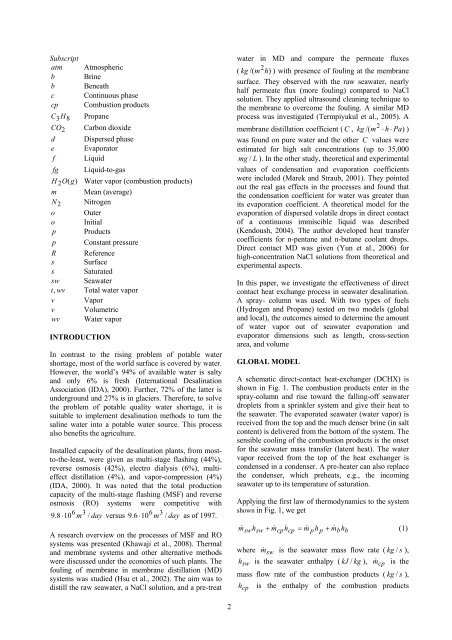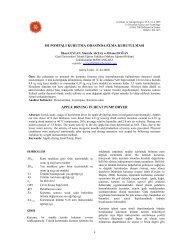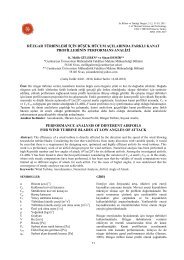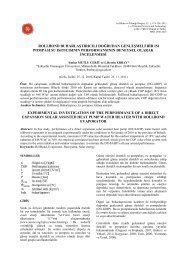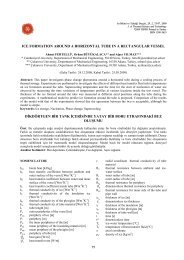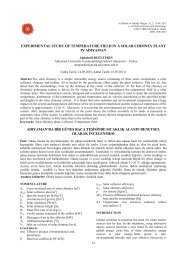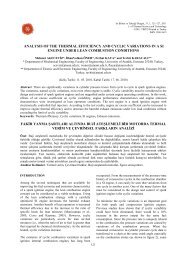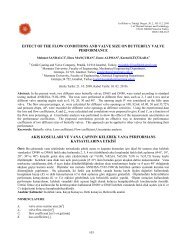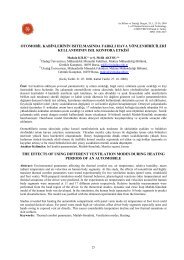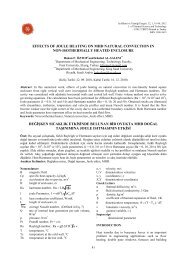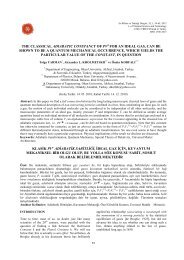seawater desalination in a direct contact heat exchanger
seawater desalination in a direct contact heat exchanger
seawater desalination in a direct contact heat exchanger
You also want an ePaper? Increase the reach of your titles
YUMPU automatically turns print PDFs into web optimized ePapers that Google loves.
SubscriptatmbbccpAtmosphericBr<strong>in</strong>eBeneathCont<strong>in</strong>uous phaseCombustion productsC 3H 8 PropaneCO 2 Carbon dioxided Dispersed phasee Evaporatorf LiquidfgLiquid-to-gasH 2O(g)Water vapor (combustion products)m Mean (average)N 2 Nitrogeno Outero Initialp Productsp Constant pressureR References Surfaces Saturatedsw Seawatert, wv Total water vaporv Vaporv Volumetricwv Water vaporINTRODUCTIONIn contrast to the ris<strong>in</strong>g problem of potable watershortage, most of the world surface is covered by water.However, the world’s 94% of available water is saltyand only 6% is fresh (International Desal<strong>in</strong>ationAssociation (IDA), 2000). Further, 72% of the latter isunderground and 27% is <strong>in</strong> glaciers. Therefore, to solvethe problem of potable quality water shortage, it issuitable to implement <strong>desal<strong>in</strong>ation</strong> methods to turn thesal<strong>in</strong>e water <strong>in</strong>to a potable water source. This processalso benefits the agriculture.Installed capacity of the <strong>desal<strong>in</strong>ation</strong> plants, from mostto-the-least,were given as multi-stage flash<strong>in</strong>g (44%),reverse osmosis (42%), electro dialysis (6%), multieffectdistillation (4%), and vapor-compression (4%)(IDA, 2000). It was noted that the total productioncapacity of the multi-stage flash<strong>in</strong>g (MSF) and reverseosmosis (RO) systems were competitive with9.8 ⋅ 106m3/ day versus 9.6 ⋅ 106m3/ day as of 1997.A research overview on the processes of MSF and ROsystems was presented (Khawaji et al., 2008). Thermaland membrane systems and other alternative methodswere discussed under the economics of such plants. Thefoul<strong>in</strong>g of membrane <strong>in</strong> membrane distillation (MD)systems was studied (Hsu et al., 2002). The aim was todistill the raw <strong>seawater</strong>, a NaCl solution, and a pre-treatwater <strong>in</strong> MD and compare the permeate fluxes( kg /( m2 h ) ) with presence of foul<strong>in</strong>g at the membranesurface. They observed with the raw <strong>seawater</strong>, nearlyhalf permeate flux (more foul<strong>in</strong>g) compared to NaClsolution. They applied ultrasound clean<strong>in</strong>g technique tothe membrane to overcome the foul<strong>in</strong>g. A similar MDprocess was <strong>in</strong>vestigated (Termpiyakul et al., 2005). Amembrane distillation coefficient ( C , kg /( m2⋅ h ⋅ Pa))was found on pure water and the other C values wereestimated for high salt concentrations (up to 35,000mg / L ). In the other study, theoretical and experimentalvalues of condensation and evaporation coefficientswere <strong>in</strong>cluded (Marek and Straub, 2001). They po<strong>in</strong>tedout the real gas effects <strong>in</strong> the processes and found thatthe condensation coefficient for water was greater thanits evaporation coefficient. A theoretical model for theevaporation of dispersed volatile drops <strong>in</strong> <strong>direct</strong> <strong>contact</strong>of a cont<strong>in</strong>uous immiscible liquid was described(Kendoush, 2004). The author developed <strong>heat</strong> transfercoefficients for n-pentane and n-butane coolant drops.Direct <strong>contact</strong> MD was given (Yun et al., 2006) forhigh-concentration NaCl solutions from theoretical andexperimental aspects.In this paper, we <strong>in</strong>vestigate the effectiveness of <strong>direct</strong><strong>contact</strong> <strong>heat</strong> exchange process <strong>in</strong> <strong>seawater</strong> <strong>desal<strong>in</strong>ation</strong>.A spray- column was used. With two types of fuels(Hydrogen and Propane) tested on two models (globaland local), the outcomes aimed to determ<strong>in</strong>e the amountof water vapor out of <strong>seawater</strong> evaporation andevaporator dimensions such as length, cross-sectionarea, and volumeGLOBAL MODELA schematic <strong>direct</strong>-<strong>contact</strong> <strong>heat</strong>-<strong>exchanger</strong> (DCHX) isshown <strong>in</strong> Fig. 1. The combustion products enter <strong>in</strong> thespray-column and rise toward the fall<strong>in</strong>g-off <strong>seawater</strong>droplets from a spr<strong>in</strong>kler system and give their <strong>heat</strong> tothe <strong>seawater</strong>. The evaporated <strong>seawater</strong> (water vapor) isreceived from the top and the much denser br<strong>in</strong>e (<strong>in</strong> saltcontent) is delivered from the bottom of the system. Thesensible cool<strong>in</strong>g of the combustion products is the onsetfor the <strong>seawater</strong> mass transfer (latent <strong>heat</strong>). The watervapor received from the top of the <strong>heat</strong> <strong>exchanger</strong> iscondensed <strong>in</strong> a condenser. A pre-<strong>heat</strong>er can also replacethe condenser, which pre<strong>heat</strong>s, e.g., the <strong>in</strong>com<strong>in</strong>g<strong>seawater</strong> up to its temperature of saturation.Apply<strong>in</strong>g the first law of thermodynamics to the systemshown <strong>in</strong> Fig. 1, we getm & swhsw+ m&cphcp= m&php + m&bhb(1)where m& sw is the <strong>seawater</strong> mass flow rate ( kg / s ),h sw is the <strong>seawater</strong> enthalpy ( kJ / kg ), m& cp is themass flow rate of the combustion products ( kg / s ),h cp is the enthalpy of the combustion products2


